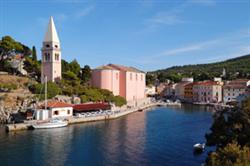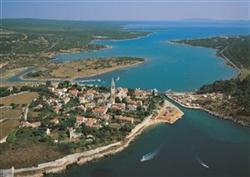Things to note
Veli Lošinj

Special and worthy of admiration is certainly parish church of St. Anthony the Hermit (Abbot) originally constructed in the 15th century, it was later restored in the Baroque style in 1774. The richest gallery of Italian masters in the entire Kvarner islands can be found here: Vivarini, Strozzi, Querena, Hayez, Cossa, Poltenza, numerous works of art, a pipe organ from the builder Callida, and a relic of St. Gregory.
Our Lady of the Angels church was built in 1510. The Veli Lošinj captains transformed it into a real art gallery.
The church of St. John, after whom the hill was named, with a panoramic view of Veli and Mali Lošinj and a hiking trail to the southernmost part of the island of Lošinj.
The Tower dates back to 1445 and was constructed to defend the harbour from invading sea pirates. The image of the tower was taken as a motif on the coat-of-arms for the town of Veli Lošinj. To-day, the tower is a museum-gallery open to all visitors to Veli Lošinj.
Rovenska Harbour - in 1856 the Austrian Archduke, Maximilian of Hapsburg, younger brother of the emperor, Franz Joseph I, admiral of the Austrian navy and later emperor of Mexico, stayed in Veli Losinj. On that occasion, he laid the cornerstone for the building of the breakwater in Rovenska. In Rovenska bay is the only olive mill in use in Veli Lošinj with its old hydraulic technology for processing olives.
Lošinj’s Marine Education Centre, where you can find out more about the Lošinj undersea world and the colony of dolphins found in this area from multimedia and interactive projections, exhibitions and lectures. Here you can also buy some nice souvenirs to keep your memories on dolphins of Lošinj archipelago.
The forest park “Podjavori” with the former winter residence of the Hapsburg Archduke Charles Stephen, now a famous sanatorium.
- CATEGORY OF PROTECTION: forest park
- AREA: 39 ha
- LOCATION: Veli Lošinj, on the slopes of the hill of Kalvarija (the Way of the Cross)
- FLORA: laurel (Laurus nobilis), holm oak (Quercus ilex), mastic tree (Pistacia lentiscus), true myrtle (Myrtus communis), laurustinus (Viburnum tinus), tangled honeysuckle (Lonicera implexa), Mediterranean cypress (Cupressus sempervirens), Aleppo pine (Pinus halepensis), stone pine (Pinus pinea), coast redwood (Sequoia sempervirens), deodar cedar (Cedrus deodara), Himalayan cypress (Cupressus torulosa), southern magnolia (Magnolia grandiflora), palms and numerous other species of dendroflora
Mali Lošinj

The walk along the shore leads you to the farthest point of Čikat, Annunziata Point, named after the votive church of the Annunciation of the Blessed Virgin Mary. This is the heart of Lošinj. Today's church, of classicist facade, was built in 1858 alongside an older, smaller church. In front of the point is the open sea, extending into the distance. From this point Lošinj women and mothers saw off ships and greeted them.
The parish church of the Nativity of the Virgin and the piazza from 1696-1775.It is a three-nave church with relics of St. Romulus and a painting of the Nativity of the Blessed Virgin Mary on the altar.
The Art Collection of Andro Vid and Katarina Mihičić and the Piperata Collection of Old Masters, containing some twenty oils on canvas and water-colours by Italian, French and Dutch painters from the 17th and 18th century.
The Lošinj Aromatic Garden – a nursery of the island medicinal herbs in Mali Lošinj.Accompanied by a qualified guide, visitors can find out about the rich island flora, the medicinal properties of the island plants and buy an original island souvenir.
Ćunski
Old olive mill for olives - «torać» open to visitors during the summer months. As part of its rich inheritance, the wish is to present and exhibit to tourists the reconstruction of TORAĆ – the only remaining old mill for olives (so-called «TORAĆ» in the local dialect) was built in 1897.
Osor

Cathedral bell tower - east of the church – is the work of Krk's master craftsman, Jakov Galeta, from 1575. In the 18th century, the bell tower was reconstructed; in 1901 it was raised to the level at which it is preserved to-day.
Museum of sacred art – A collection of sacred art located in the Bishop's palace was established in 1997 with material from the treasury of Osor Cathedral.
Osor's garden sculptures «Sculpture and Music» - A row of bronze sculptures based on the theme of music. The sculptures are laid during that period of the year when Osor's Musical Evenings are held, enriching Osor with the works of important Croatian sculptors. Thus, the idea was born to place a row of statues with reproductions from the most famous Croatian sculptors such as Ivan Meštrović, Fran Kršinić,Vanje Radauš, Ivan Rosandić and Belizar Bahorić, creating a unique sculpture line, as well as original works of Marija Ujević dedicated to the musician Jakov Gotovac.











